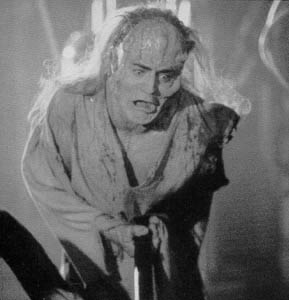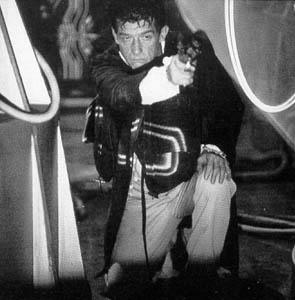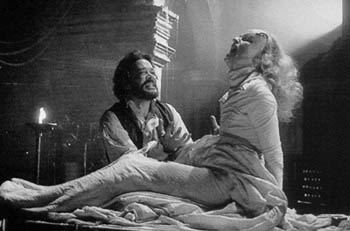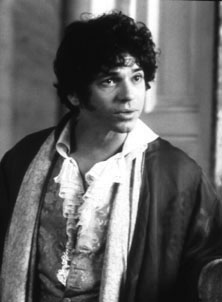|
Frankenstein films in the 1990s
Frankenstein Unbound (1990)
One of the most
interesting adaptations of Shelley's novel is
Frankenstein Unbound, directed by B-movie king Roger Corman and based on a novel by science fiction author Brian W. Aldiss,
published in 1975. In this reconstruction of
Frankenstein a time traveller meets both Victor Frankenstein and
Mary Shelley, which implies that her novel might not be a work of
fiction but instead is partly based on facts and therefore so-called "faction".
Synopsis:
The film begins in a snow-covered wasteland where a lonesome man, Dr. Joseph Buchanan
(in Aldiss' novel called Bodenland), is telling his story. The narrative then shifts to the year 2031, where Buchanan is testing his latest invention, a laser weapon. It soon turns out that his experiments have distorted the time-space continuum and
eventually Buchanan is
sucked into a time-space hole and teleported to Switzerland in the year 1817. There he meets Dr. Victor Frankenstein, who has just brought his creature to life, encounters the
Monster and visits the trial against Justine, who is accused of having murdered Frankenstein's little brother. At the trial he also runs into
young Mary Shelley.
Buchanan visits her, tells her that one day she will become a famous author and
eventually seduces her. Meanwhile Frankenstein has decided to make a bride for the Monster. After the creature has killed Frankenstein's fiancée Elizabeth, Victor forces
Buchanan to help him resurrect her by using energy from his computer-driven
car. The experiment is successful, but at the same time Buchanan activates his laser
weapon,
creating another time-space anomaly. Victor, the Monster, Buchanan and Elizabeth
are teleported to an unknown place in time and space: the snow-covered wasteland
from the beginning of the film. There the resurrected Elizabeth kills herself after having realised her
miserable monstrous existence. Eventually, the Monster murders Frankenstein and flees into the ice. In a
futuristic subterranean computer laboratory Buchanan finally confronts and
destroys the Monster.

The Monster (Nick Brimble) is impaled on a pole
|
According to the film's notion that "man has power to invent, but not to control" (Aldiss 1982:
77)
Frankenstein Unbound presents not only one, but two Frankensteins, both of them
"Promethean transgressors", who fail in their experiments. Like Walton in
Shelley's Frankenstein, Dr. Joseph Buchanan is constructed as a parallel figure to Victor
Frankenstein; in fact, here he replaces Walton. The first hint at this is the
movie's narrative framework, where Buchanan tells the story in an icy
wasteland resembling the Arctic setting from Shelley's novel. His invention, the laser weapon, is his
own uncontrollable monster. But the consequences of his invention are far more severe than in Frankenstein's case, because Buchanan's laser causes a
breach in the space-time continuum and thus changes the whole universe
completely . Buchanan is
well aware of his fatal transgression, when he says that like Frankenstein
he made a monster, but wanted to do it for mankind's benefit. His parallels
with Victor Frankenstein become more obvious;
when he zaps Frankenstein and himself into an
|
unknown place he proclaims, "Meet MY monster!" and before killing the creature he finally realises, "I am Frankenstein!" Although he has
destroyed Frankenstein's Monster, Buchanan will never be able to reverse his own fatal invention. When he sees a strange futuristic city, he
still hears the Monster's
voice proclaiming, "You think you have killed me but I am with you forever.
I am unbound." Since his creation has changed the whole universe, Buchanan, a
21st century Frankenstein and probably the last human being alive, will always be haunted by his invention.
In the first half of the film Corman and Aldiss stick closely to Shelley's original. Many aspects of the
story which were left out in most filmed versions are now included, in particular the killing of William Frankenstein, the trial against Justine and the Monster demanding a bride.
Aldiss cleverly adds historical facts surrounding the genesis of the novel
Frankenstein, when Buchanan meets Mary Shelley, Lord Byron and Percy Shelley at Lake Geneva.
|

Buchanan (John Hurt), a man of action
|

Frankenstein (Raul Julia) and the Bride
(Catherine Rabett)

Late rock singer Michael Hutchence as
Percy Shelley |
Even the characteristics of Corman's Monster are very similar to those of the
Monster in Shelley's original novel. He is a pitiful creature, who is rejected by society and
left alone by the man who made him. The Monster can talk and think, and the most pressing question of his existence is that of
his origin. He constantly asks people if they were also made by Frankenstein. When Buchanan tells him, that he was maybe made by God, the Monster wants to know who this God is. Like in the novel
his violent behaviour is rooted in Frankenstein's rejection of his own creation.
The film's ending also suggests parallels between Frankenstein's creature
and Buchanan's monstrous invention: When Buchanan kills the monster in the
futuristic laboratory it is in fact his own creation that he wants to
eliminate. The creature understands this fact and warns Buchanan,
"You do not understand. You cannot kill me!" Both creations will forever
haunt mankind: Frankenstein's monster in horror stories and Buchanan's
invention by messing up time and space forever.
On the other hand, Corman's movie portrays
Victor Frankenstein in a more negative way than Mary Shelley. He is arrogant and
rarely shows emotions, not even when Elizabeth is killed. Victor also
refuses to see his mistakes. When Buchanan confronts him and calls his work a sin, Victor simply states, "I am a scientist. I cannot sin."
He believes himself a God who is always right and never fails. Therefore Buchanan comes much closer to Shelley's concept of the scientist
who regrets his transgression than Corman's Victor Frankenstein.
|
Frankenstein Unbound marked
Roger Corman's return to directing movies after almost two decades.
Although the story has great potential the movie suffers from its low
budget (the Arctic setting looks like from a 1960s Star Trek episode),
some bad special effects and various inconsistencies (For
example, why does everybody in 19th-century Switzerland speak English?). Other
aspects of the film are more promising, such as the fine performances by
Raul Julia and
two-times Oscar nominee John Hurt. On the other hand
some elements ultimately make the film look
much cheesier than it could have been, for example the talking car, although designed by
famed Italian automobile designer Giugiaro, is
still reminiscent of Knight Rider's KITT.
| Cast & Crew: |
|
| |
|
|
Dr.
Joe Buchanan |
John Hurt |
| Victor
Frankenstein |
Raul Julia |
| Mary
Shelley |
Bridget
Fonda |
| Lord Byron |
Jason Patric |
| Percy Byshee Shelley |
Michael Hutchence |
| The Creature |
Nich Brimble |
| Elizabeth Levenza |
Catherine Rabett |
| |
|
| |
|
|
Screenplay |
Roger Corman
F.X. Feeney
based on a novel by
Brian Aldiss |
| Music |
Carl Davis |
|
Cinematography |
Armando Nannuzzi
Michael Scott |
|
Producers |
Roger Corman
Jay Cassidy
Kobi Jaeger
Laura Medina
Thom
Mount |
| Director |
Roger Corman |


|

